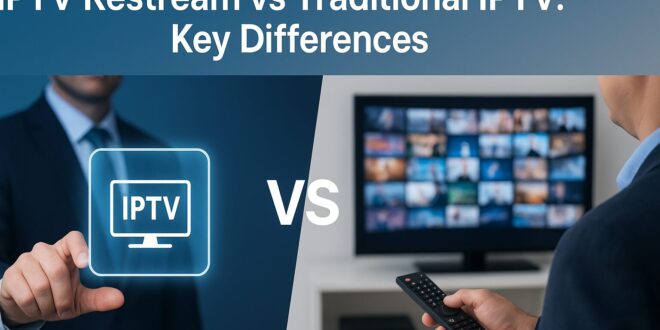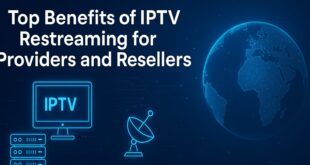IPTV Restream vs Traditional IPTV: Key Differences. IPTV Restreaming-Porch vs. old-school IPTV: The Important Differences Now, Internet Protocol Television (IPTV) is revolutionizing all through the very dramatic changes in forms of entertainment, and it has continued to do so for years now. It is an old thing, but its new branches, especially IPTV Restreamin,g are really coming into focus in 2025. Whether you are an IPTV provider, reseller, or end-user hoping to have an understanding of what these technologies can do for you, you should realize that some major differences exist between IPTV Restream and Traditional IPTV.
These two IPTV models have been discussed in detail in this article, including comparisons on infrastructures, cost efficiency, presentation to users, scalability, legal implications, and more. By the end of the guide, you will know not only how the technology works but also which is a better fit for your company or personal streaming requirements.
- Table of Contents
- What is IPTV?
- What is Traditional IPTV?
- What is IPTV Restream?
- How IPTV Restreaming Works
- Technical Infrastructure Comparison
- Content Delivery & Latency
- Scalability & Flexibility
- Bandwidth and Server Resource Usage
- Cost Structure and Investment
- Monetization Opportunities
- Security & Reliability
- User Experience and Playback Quality
- Legal and Licensing Considerations
- Which One is Better for Resellers?
- Which One is Better for End Users?
- Future Trends in IPTV
- Conclusion
Website Link: https://bigoiptv.com/iptv-restream.php
Contact Us: https://api.whatsapp.com/send/?phone=923096200005
1. What is IPTV?
Internet Protocol Television (IPTV) is a method of delivering television content over the Internet as opposed to through traditional means such as cable or satellite signals. IPTV is the middle ground between the other popular over-the-top (OTT) services such as Netflix or YouTube. IPTV would require a set-top box as part of an interactive managed service from a service provider.
It essentially works like video-on-demand television using internet protocols that transmit video data through a secure and private network. Types of IPTV services are:
- Live television broadcasts
- Video on Demand (VoD)
- Time-shifting (pause, rewind, catch-up)
2. What is Traditional IPTV?
Traditional IPTV is what most people really refer to when they say IPTV in general. Streaming content directly from a provider’s server to the end user: that’s what it is. The provider purchases access to content, stores it on its servers, and broadcasts the same directly to its customers.
- Key Characteristics:
Content and management of servers are hosted by the provider. - Direct connections are between end users and the source server.
- Increased control and stability for providers.
- Higher costs of infrastructure and bandwidth.
3. What is IPTV Restream?
IPTV Restreaming, or just “restream,” is a model where a reseller or small service provider gets an already existing IPTV stream from another provider and retransmits that stream to its clientele.
- Key Characteristics:
Does not host original content. - Merely relays streams obtained from a master provider.
- Minimum requirements for the infrastructure.
- Set up much faster and cheaper.
4. How IPTV Restreaming
Works Imagine a master IPTV provider who works to fulfill all requirements, such as content licenses, streaming servers, and a well-optimized infrastructure. So, a restreamer subscribes to the service of this company, accesses the content feed, and redistributes it to its users, unmodified or remodulated (branding, packaging, etc.).
Most restreamers operate on a subscription basis, selling bundles to end users much like traditional IPTV, but the source of content for that bundle is not directly owned or managed by them at all.
5. Technical Infrastructure Comparisons
- Traditional IPTV
- Requires dedicated servers to store content and deliver other services.
- Needs a solid backend where middleware, CMS, and EPG systems exist.
- Must manage load balancing, CDN integration, and redundancy.
- IPTV Restream
Requires, at most, a relay server or, sometimes, just a player. - Minimal setup; generally cloud-based.
- Designed for fast scaling and new startup businesses.
- Verdict: Traditional IPTV involves more control, but it’s also more complex and costly. Restreaming goes light and fast.
6. Content Delivery and Latency
- Traditional IPTV:
- Direct delivery with low latency.
- Better for high-resolution streams.
- Can implement CDNs for better delivery.
- IPTV Restream:
- Slight delay because of signal relaying.
- Dependent on the master provider’s speed and quality.
- Buffering might occur with poor upstream quality.
- Verdict: In general, low latency translates into smooth streaming for traditional IPTV.
7. Scalability and Flexibility
Traditional IPTV:
To scale requires server upgrades and bandwidth expansion.
Operationally complex as one grows users.
IPTV Restream:
Can scale quickly by just upgrading the restream packages.
Best suited for kickoff and small resellers.
Verdict: Restreaming wins for fast scaling with flexibility; Traditional IPTV suits a long-term expansion into enterprise.
 BIGO IPTV BLOG Ultimate IPTV Player App Stream Live TV On-Demand Content
BIGO IPTV BLOG Ultimate IPTV Player App Stream Live TV On-Demand Content







